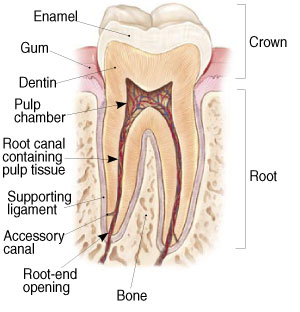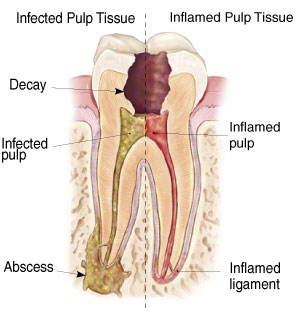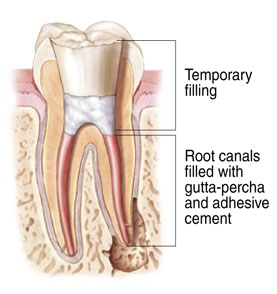Services FAQ
What is root canal treatment?
Endodontic — or root canal — treatment is necessary when the pulp, the soft tissue inside the root canal, becomes inflamed or infected. The inflammation or infection can have a variety of causes, such as: deep decay, repeated dental procedures on the tooth, or a crack or chip in the tooth.
Root canal treatment removes the damaged pulp, or soft inner tissue containing nerves and blood vessels, from the tooth, and then the endodontist cleans, fills and seals the canals.



What is a retreatment of root canal treatment?
Occasionally following root canal treatment, the tooth may not heal or a new problem affects a previously treated tooth. During retreatment, the endodontist removes the root canal filling material and disinfects the canals. Often the canals are medicated and refilled with gutta percha (root canal filling material) and cement on a second visit.
What is an apicoectomy, or root end surgery?
In this procedure, the gum tissue is opened near the tooth to see the underlying bone and remove any inflamed or infected tissue. The end of the root is also removed. A small filling may be placed in the root to seal the end of the root canal, and a few stitches or sutures are placed to help the tissue heal properly. The bone will then start to heal around the end of the root.
How will my cracked tooth be treated?
Cracked teeth can display a variety of symptoms and can be challenging to diagnose. The tooth can be intermittently sensitive to temperature and upon biting. An endodontist is an expert in cracked teeth. Factors such as the type of crack, location, severity and length of time present can determine the treatment recommended. The sooner a cracked tooth is addressed, the better the long-term outcome.
What is a traumatic dental injury?
Traumatic dental injuries typically occur due to a sports injury or some other type of accident. The injury can be minor such as a “chipped” tooth or as serious as a fractured jaw. Depending on the severity, type and location of the injury, treatment can vary.
What is an apexification?
Apexification is a procedure to help form a hard barrier at the end of the root(apex) of an immature tooth or damaged root end. By closing the root end with a specialized dental material, the goal is to seal the root canal system to induce healing.
What is non-vital bleaching?
Non-vital bleaching is a whitening treatment to lighten staining of the inner layer of the tooth. A tooth that needs root canal treatment may have discoloration. This discoloration is an intrinsic stain, meaning the stain is within the tooth and not a superficial stain from coffee, wine, or natural aging of the tooth. The discoloration typically occurs from trauma when dried blood sits in the tooth.
Regeneration of the dental pulp?
Regenerative endodontics utilizes tissue engineering technology to help a diseased immature root continue to develop. The is a developing area of endodontics and will continue to evolve.
